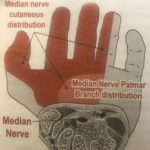In a wrist sprain, the ligaments around the wrist are stretched or torn. As is the case with all ligament injuries, the severity is graded from I-III. Osteopathy possesses a number of techniques that are very effective in the treatment of wrist problems, including wrist sprains.
What causes wrist sprain?
It is caused by excessive loading of the ligaments during hyperextension of the wrist, for example due to a fall on an outstretched hand (FOOSH).
Wrist sprains can be due to a single trauma (usually a FOOSH) or due to repetitive microtrauma or overuse.
The mechanism of injury underlying a wrist sprain is also likely to effect other structures. Therefore, a FOOSH may not only cause a sprained wrist, but also a scaphoid fracture, a lunate dislocation, a triangular fibrocartilage tear, or, especially in osteoporotic patients, a fracture of the radius.
Who gets it?
Anyone who falls onto an outstretched hand is likely to suffer a wrist sprain. However, it is important to remember that wrist sprains are a common repetitive stress injury as well. As such, massage therapists, osteopaths, office workers, and gymnasts may be effected.
What are the symptoms of a wrist sprain?
The main symptom is dull pain localised to the wrist, with sharp pain when the wrist is challenged with movement. There may be swelling.
If left untreated, a wrist sprain will lead to instability which can develop into osteoarthritis.
How is a sprained wrist diagnosed?
Knowing the mechanism of injury, and palpating and testing movement of the wrist are usually sufficient to diagnose a wrist sprain.
If, however, the injury is moderate or severe or there is no improvement in the first two weeks, an x-ray to rule out a fracture is indicated. To rule out an occult scaphoid fracture, the x-ray needs to be performed two weeks after the injury. This is because an early x-ray may not show the fracture.
What are the treatments for wrist sprain?
Conventional techniques
As is the case with most acute musculoskeletal injuries, the first few days should focus on PRICE (protect, rest, ice, compress, elevate).
More precisely, you should protect the wrist by avoiding aggravating movements and wearing a brace. Repeatedly icing, and compressing the wrist in the first 24 to 48 hours helps reduce local inflammation.
Strapping the wrist is easy and a product I use regularly is elastic adhesive bandage.
Massage
A massage therapist will work with the forearm muscles. A massage therapist will also use techniques to promote fluid movement.
Acupuncture
An acupuncturist will work with the local wrist points SI6, SJ3, SJ10, LV3 and GB34. An acupuncturist will also work with the meridians/channels that run along the arm.
Surgery
Although very rarely carried out, surgery may involve partial wrist fusion.
Can osteopathy help a wrist sprain?
It is important to gently correct misalignments of the bones that make up the wrist early on—and osteopathy is amazing at this!
As an osteopath who uses AK, I use advanced muscle testing to diagnose the exact joint dysfunctions. I also address the nerve supply to the muscles that cross the wrist and treat reactive muscle patterns, where one muscle can inhibit another.
I also work with the proprioception of the joints around the wrist.
Osteopathy is very effective in the treatment of both acute and chronic wrist sprains. I often see significant improvement in the first two appointments.
If you sprained your wrist, please do not hesitate to get in touch.
To book an Osteopathy appointment in New Malden or in Marylebone, phone 020 8942 3148 or contact Aston Clinic London.
Aston Clinic London is a third-generation complementary health clinic based in New Malden and serves the local areas of Kingston, Wimbledon, Raynes Park, Surbiton, Chessington, Worcester Park, Sutton and other areas of southwest London and Surrey.
Aston Clinic London also offers Osteopathy and Herbal Medicine in Marylebone, Central London.

